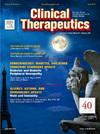Treatment of Pain in Cirrhosis: Advice to Caregivers of Those with Rock Livers
IF 3.2
4区 医学
Q2 PHARMACOLOGY & PHARMACY
引用次数: 0
Abstract
Purpose
When one considers the significant role of the liver in medication absorption and metabolism, clinicians must appreciate the important ramifications for medication dosing and monitoring in patients with cirrhosis. For many medications, dose adjustments may be necessary to minimize toxicities or avoid adverse effects from drug accumulation. Clinicians could be well served if they can understand in some detail how pharmacokinetic properties are altered in cirrhosis.
Methods
A PubMed search of the English medical literature starting with 1980 using keywords cirrhosis, pain management, and analgesics was performed, and additional papers were found using references from the first round of papers.
Findings
Patients with cirrhosis often have significant reductions in first-pass metabolism, altered volumes of distribution, and marked reductions in both renal and hepatic elimination of drugs. These factors may contribute to much higher levels of drug exposure compared to the general population. In terms of drug dosing, FDA labeling is often ambiguous and even incongruous with observed pharmacokinetic changes.
Implications
This article may provide guidance for clinicians to optimize pain management in people living with cirrhosis.
Key Message
Current FDA labeling for dosing analgesic drugs in patients with cirrhosis is either vague or not consistent with findings from newer pharmacokinetic research. With this review, we hope to provide insight and guidance to clinicians on how to dose-adjust medications commonly utilized in pain management in these patients.
肝硬化疼痛的治疗:给 "石肝 "患者护理人员的建议。
目的:考虑到肝脏在药物吸收和代谢中的重要作用,临床医生必须了解肝硬化患者用药剂量和监测的重要影响。对于许多药物来说,可能需要调整剂量以减少毒性或避免药物蓄积引起的不良反应。如果临床医生能详细了解肝硬化患者的药代动力学特性是如何改变的,他们将受益匪浅:方法:使用肝硬化、疼痛管理和镇痛药等关键词,从1980年开始在PubMed上搜索英文医学文献,并通过第一轮论文的参考文献找到其他论文:研究结果:肝硬化患者的首过代谢通常显著降低,分布容积改变,肾脏和肝脏对药物的排出量明显减少。这些因素可能导致药物暴露水平远高于普通人群。在药物剂量方面,美国食品及药物管理局的标签往往含糊不清,甚至与观察到的药代动力学变化不一致:本文可为临床医生优化肝硬化患者的疼痛治疗提供指导:目前美国食品药物管理局(FDA)对肝硬化患者镇痛药物剂量的标注要么含糊不清,要么与较新的药代动力学研究结果不一致。通过这篇综述,我们希望为临床医生提供见解和指导,帮助他们了解如何调整肝硬化患者疼痛治疗中常用药物的剂量。
本文章由计算机程序翻译,如有差异,请以英文原文为准。
求助全文
约1分钟内获得全文
求助全文
来源期刊

Clinical therapeutics
医学-药学
CiteScore
6.00
自引率
3.10%
发文量
154
审稿时长
9 weeks
期刊介绍:
Clinical Therapeutics provides peer-reviewed, rapid publication of recent developments in drug and other therapies as well as in diagnostics, pharmacoeconomics, health policy, treatment outcomes, and innovations in drug and biologics research. In addition Clinical Therapeutics features updates on specific topics collated by expert Topic Editors. Clinical Therapeutics is read by a large international audience of scientists and clinicians in a variety of research, academic, and clinical practice settings. Articles are indexed by all major biomedical abstracting databases.
 求助内容:
求助内容: 应助结果提醒方式:
应助结果提醒方式:


